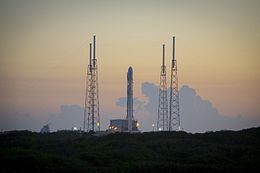Falcon 9 Flight 20

Falcon 9 v1.2FT on SLC-40 on 16 December 2015
|
|
| Rocket | Falcon 9 |
|---|---|
| Configuration | Falcon 9 Full Thrust |
| Flight no. | 20 |
| Manufacturer | SpaceX |
| Operator | SpaceX |
| Launch | |
| Date | 01:29:00, 22 December 2015 |
| Site | Cape Canaveral, Florida, U.S. |
| Pad | Space Launch Complex 40 |
| Payloads | |
| 11 Orbcomm-OG2 satellites | |
Falcon 9 Flight 20 (also known as Orbcomm OG2 M2) was a Falcon 9 space launch that occurred on 22 December 2015 at 01:29 UTC (21 December, 8:29 pm local time). It was the first time that the first stage of an orbital rocket made a successful return and vertical landing.
The successful landing of the first stage at Landing Zone 1, near the launch site, was the end result of a five-year technology development program to develop a reusable launch system and came on a flight test that followed the primary launch mission. Following separation of the second stage, SpaceX conducted the eighth of its controlled booster descent tests of the spent first stage, the first in which the descent target location was on land, and also the first ever successful landing. Prior to this flight, SpaceX's two previous attempts at a vertical landing and booster recovery ended in failure to recover the rocket. The success of Flight 20 marked a significant milestone en route to the company’s goal of creating a reusable rocket system that would significantly reduce the cost of launching payloads into orbit.
Falcon 9 Flight 20 was the first launch of the substantially upgraded Falcon 9 full thrust version of the Falcon 9 launch vehicle. It carried 11 Orbcomm-OG2 satellites to Earth orbit.
The launch was also notable as it was the first SpaceX launch following the catastrophic failure of a Falcon 9 v1.1 launch vehicle's second stage on Falcon 9 Flight 19 in June 2015.
SES announced in February 2015 that it would provide the payload on the first launch of the revised-design Falcon 9 Full Thrust (also called Falcon 9 v1.2 ). At the time, SES expected its SES-9 geostationary communications satellite would launch by September 2015. SES kept the decision despite the loss of the launch vehicle and payload of another SpaceX mission in June 2015, but postponed the launch until late 2015.
...
Wikipedia
